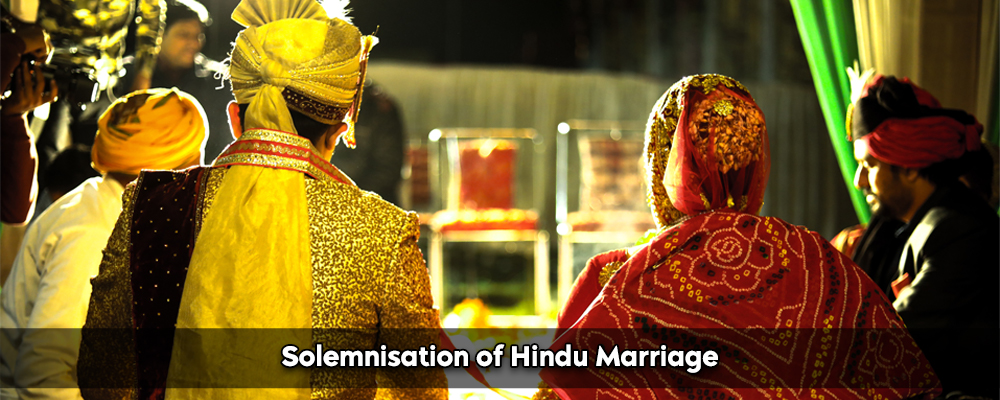According to Section 2 of the Hindu Marriage Act of 1955, this law applies to anyone who is a Hindu by birth or who has converted to one of the religion’s several forms, including Virashaiva, Lingayat, Brahmo, Prarthana, or Arya Samaj. This law also applies to everyone who practices Buddhism, Jainism, or Sikhism. It also applies to everyone living outside of this territory, except those who are Muslims, Christians, Parsis, or Jews by faith or who can be proven to be subject to Hindu law. The strongest tie between a husband and wife is thought to exist here. It is an enduring tie that endures even after death.
Need A Legal Advice
The internet is not a lawyer and neither are you. Talk to a real lawyer about your legal issue

Features of a Hindu Marriage’s Sacramental Nature
Marriage in Hinduism is referred to as “a religious sacrament in which a man and a woman are bound in a permanent relationship for the physical, social, and spiritual need of dharma, procreation, and sexual pleasure.” The sacramental aspect of marriage has the following three features:
- They will continue to be together after death because of their enduring link, which is permanent and tied even after death.
- It cannot be undone once tied.
- The bride and groom’s marriage is a sacred and religious one, hence religious rites and ceremonies must be done.
Among the most significant sacraments in Hinduism is marriage. There was no requirement for the females’ permission in antiquity. Without seeking her opinion or consent, the father must decide between the boys. The father must look for a suitable boy on his own. It was not regarded as a null marriage if the person was mentally incapacitated or a minor at the time of the marriage. However, in the modern world, the permission and mental stability of the person are very important components of the Hindu marriage; without the presence of any such factor, the marriage will be void or have no legal status.
According to Section 12 of the Hindu Marriage Act of 1955, a marriage is deemed null and void if no one’s permission is obtained. It demonstrates that the marriage is legitimate and legal even though the bride’s permission was not given. Marriage today is contractual. Thus, it acknowledges the concepts of liberty and equality. Western ideas are to blame for its adoption. Both parties must agree to enter into it on their own free will. Thus, a Hindu marriage is neither a sacrament nor a contract. But it is possible to say that it has elements of both.
Saptapadi
The Saptapadi is a crucial and essential part of a conventional Hindu wedding. The bride and groom participate in a ritual in which they circle the sacred fire seven times while exchanging vows in front of the fire god. This motion is often referred to as phera. In the Hindu religion, fire, or Agni, is regarded as extremely sacred; pledges made in front of the Agni are unbreakable. The deity of fire, Agni deva, is regarded as a witness to the marriage’s solemnization and as the supreme being’s emissary to bestow his blessing on the newlyweds. A Hindu marriage may be solemnized by all of the ceremonies and rituals of both parties or by anyone, according to Section 7 of the Hindu Marriage Act of 1955. It is about the Saptapadi, which entails seven rounds around the fire with one’s partner; after it is finished, marriage is considered complete.
Case Law
In the case of Smriti Singh Alias Mausami Singh And 3 Others vs. State of U.P. and Another, the Allahabad High Court ruled that certain rites, such as the “Saptapadi” ceremony, which involves the bridegroom and bride taking seven steps together in front of a sacred fire, must be carried out before a Hindu marriage may be considered “solemnized.” The Court stated that there was insufficient evidence regarding the performance of the Saptapadi ceremony in the alleged second marriage in the current case, noting that the parties before the Court are Hindus and that the ‘Saptapadi’ ceremony is one of the requirements for forming a valid marriage under Hindu Law.
The bench also considered the absence of any allegations regarding “Saptapadi” in the complaint or the statements made by Sections 200 and 202 of the CrPC. The Court determined that the fundamental elements necessary to form an offense under Section 494 read with Section 109 of the IPC were missing as a result, and as a result, no offense was made out against the applicants, even after adopting the complaint’s contents at face value.
Lead India provides a range of legal services, including online resources and free legal advice. You can talk to a lawyer as soon as you have Lila. Ask a legal question for advice.





 Talk to a Lawyer
Talk to a Lawyer